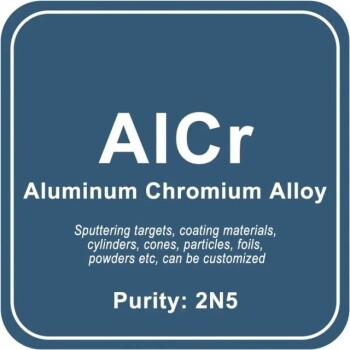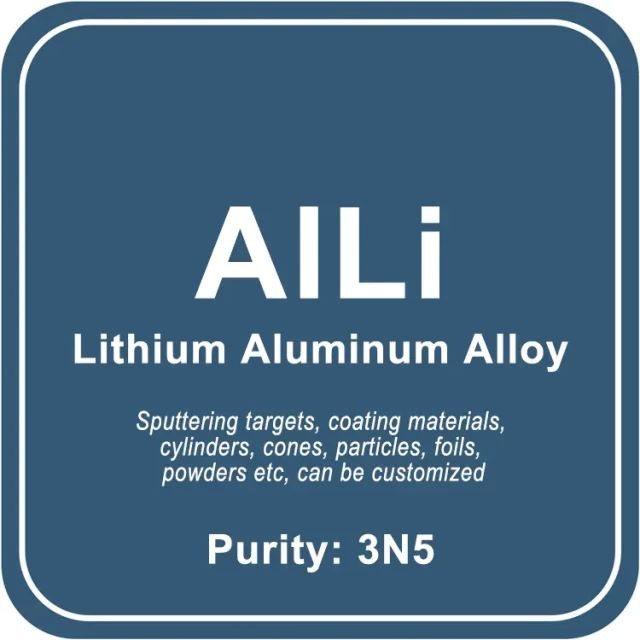
Lab Materials
Lithium Aluminum Alloy (AlLi) Sputtering Target / Powder / Wire / Block / Granule
Item Number : LM-AlLi
Price varies based on specs and customizations
- Chemical Formula
- Chemical Formula
- Purity
- 3N5
- Commonly Used Ratio
- Al:Li=95:5 wt%
- Shape
- discs / wire / block / powder / plates / column targets / step target / custom-made

Shipping:
Contact us to get shipping details Enjoy On-time Dispatch Guarantee.
We offer Lithium Aluminum Alloy (AlLi) materials for laboratory use. Our expertise lies in producing and tailoring Lithium Aluminum Alloy (AlLi) materials of varying purities, shapes, and sizes to meet your specific needs.
We provide a wide range of specifications and sizes for various forms of AlLi materials, including sputtering targets (circular, square, tubular, irregular), coating materials, cylinders, cones, particles, foils, powders, 3D printing powders, nanometer powders, wire rods, ingots, and blocks.
Details

About Lithium Aluminum Alloy (AlLi)
Lithium Aluminum is a versatile material available in various forms such as bars, ingots, ribbons, wires, shots, sheets, and foils. These forms can be tailored to meet specific requirements, including ultra-high purity and high purity forms that include metal powder, submicron powder, and nanoscale.
Furthermore, Lithium Aluminum is also used in thin film deposition, making it suitable for the manufacture of targets for physical and chemical vapor deposition applications. Pellets made from this material can be used for both CVD and PVD applications, enhancing the versatility of this material in various industries.
Ingredient Quality Control
- Raw material composition analysis
- Through the use of equipment such as ICP and GDMS, the content of metal impurities is detected and analyzed to ensure that it meets the purity standard;
Non-metallic impurities are detected by equipment such as carbon and sulfur analyzers, nitrogen and oxygen analyzers. - Metallographic flaw detection analysis
- The target material is inspected using flaw detection equipment to ensure that there are no defects or shrinkage holes inside the product;
Through metallographic testing, the internal grain structure of the target material is analyzed to ensure that the grains are fine and dense. - Appearance and dimension inspection
- Product dimensions are measured using micrometers and precision calipers to ensure compliance with drawings;
The surface finish and cleanliness of the product are measured using a surface cleanliness meter.
Conventional Sputtering Target Sizes
- Preparation process
- hot isostatic pressing, vacuum melting, etc.
- Sputtering target shape
- plane sputtering target, multi-arc sputtering target, step sputtering target, special-shaped sputtering target
- Round sputtering target size
- Diameter: 25.4mm / 50mm / 50.8mm / 60mm / 76.2mm / 80mm / 100mm / 101.6mm / 152.4mm
Thickness: 3mm / 4mm / 5mm / 6mm / 6.35mm
Size can be customized. - Square sputtering target size
- 50×50×3mm / 100×100×4mm / 300×300×5mm, size can be customized
Available Metal Forms
Metal Forms Details
We manufacture almost all the metals listed on the periodic table in a wide range of forms and purities, as well as standard sizes and dimensions. We can also produce custom-made products to meet specific customer requirements, such as size, shape, surface area, composition, and more. The following list provides a sample of the forms we offer, but it is not exhaustive. If you need laboratory consumables, please contact us directly to request a quote.
- Flat/Planar Forms: Board, Film, Foil, Microfoil, Microleaf, Paper, Plate, Ribbon, Sheet, Strip, Tape, Wafer
- Preformed Shapes: Anodes, Balls, Bands, Bars, Boats, Bolts, Briquettes, Cathodes, Circles, Coils, Crucibles, Crystals, Cubes, Cups, Cylinders, Discs, Electrodes, Fibers, Filaments, Flanges, Grids, Lenses, Mandrels, Nuts, Parts, Prisms, Pucks, Rings, Rods, Shapes, Shields, Sleeves, Springs, Squares, Sputtering Targets, Sticks, Tubes, Washers, Windows, Wires
- Microsizes: Beads, Bits, Capsules, Chips, Coins, Dust, Flakes, Grains, Granules, Micropowder, Needles, Particles, Pebbles, Pellets, Pins, Pills, Powder, Shavings, Shot, Slugs, Spheres, Tablets
- Macrosizes: Billets, Chunks, Cuttings, Fragments, Ingots, Lumps, Nuggets, Pieces, Punchings, Rocks, Scraps, Segments, Turnings
- Porous and Semi-Porous: Fabric, Foam, Gauze, Honeycomb, Mesh, Sponge, Wool
- Nanoscale: Nanoparticles, Nanopowders, Nanofoils, Nanotubes, Nanorods, Nanoprisms
- Others: Concentrate, Ink, Paste, Precipitate, Residue, Samples, Specimens
KinTek specializes in the manufacturing of high-purity and ultra-high-purity materials with a purity range of 99.999% (5N), 99.9999% (6N), 99.99995% (6N5), and in some cases, up to 99.99999% (7N). Our materials are available in specific grades, including UP/UHP, semiconductor, electronic, deposition, fiber optic, and MBE grades. Our high-purity metals, oxides, and compounds are specifically crafted to meet the rigorous demands of high-technology applications and are ideal for use as dopants and precursor materials for thin film deposition, crystal growth of semiconductors, and synthesis of nanomaterials. These materials find use in advanced microelectronics, solar cells, fuel cells, optical materials, and other cutting-edge applications.
Packaging
We use vacuum packaging for our high-purity materials, and each material has specific packaging tailored to its unique characteristics. For instance, our Hf sputter target is externally tagged and labeled to facilitate efficient identification and quality control. We take great care to prevent any damage that could occur during storage or transportation.
4.8
out of
5
KINTEK SOLUTION's Lithium Aluminum Alloy (AlLi) products are top-notch! They consistently deliver high-quality materials that meet our stringent research requirements.
4.9
out of
5
The Lithium Aluminum Alloy (AlLi) sputtering targets from KINTEK SOLUTION are game-changers! They have significantly improved the efficiency and precision of our thin-film deposition processes.
4.7
out of
5
I highly recommend KINTEK SOLUTION's Lithium Aluminum Alloy (AlLi) powders. They are exceptionally pure and consistent, leading to superior results in our material synthesis experiments.
5.0
out of
5
KINTEK SOLUTION's Lithium Aluminum Alloy (AlLi) wires are remarkable! They offer excellent ductility and weldability, making them ideal for our demanding applications.
4.6
out of
5
The Lithium Aluminum Alloy (AlLi) blocks from KINTEK SOLUTION are exceptionally durable and long-lasting. They withstand high temperatures and harsh conditions without compromising their integrity.
4.8
out of
5
KINTEK SOLUTION's Lithium Aluminum Alloy (AlLi) granules are incredibly versatile. They can be easily shaped and processed, making them suitable for various research and industrial applications.
4.9
out of
5
I'm consistently impressed with the quality and consistency of KINTEK SOLUTION's Lithium Aluminum Alloy (AlLi) products. They are a reliable partner for our advanced materials research.
5.0
out of
5
KINTEK SOLUTION's Lithium Aluminum Alloy (AlLi) sputtering targets have revolutionized our thin-film deposition processes. They deliver exceptional uniformity and adhesion, resulting in high-performance coatings.
4.7
out of
5
The Lithium Aluminum Alloy (AlLi) powders from KINTEK SOLUTION are indispensable in our battery research. Their high purity and fine particle size contribute to the superior performance of our battery cells.
4.8
out of
5
KINTEK SOLUTION's Lithium Aluminum Alloy (AlLi) wires are a lifesaver for our microelectronics fabrication. They enable precise and reliable wire bonding, ensuring the integrity of our electronic circuits.
4.9
out of
5
I highly recommend KINTEK SOLUTION's Lithium Aluminum Alloy (AlLi) blocks for high-temperature applications. They exhibit exceptional thermal stability and resistance to creep, making them ideal for demanding environments.
5.0
out of
5
KINTEK SOLUTION's Lithium Aluminum Alloy (AlLi) granules are a versatile addition to our materials science research. Their unique properties open up new possibilities for exploring novel materials and applications.
4.7
out of
5
I'm amazed by the purity and consistency of KINTEK SOLUTION's Lithium Aluminum Alloy (AlLi) products. They consistently meet our stringent quality standards, ensuring reliable and reproducible results in our research.
4.8
out of
5
KINTEK SOLUTION's Lithium Aluminum Alloy (AlLi) sputtering targets have significantly improved the efficiency of our thin-film deposition processes. We've seen a remarkable increase in productivity and reduced downtime.
4.9
out of
5
The Lithium Aluminum Alloy (AlLi) powders from KINTEK SOLUTION are a game-changer for our battery research. They have enabled us to achieve higher energy densities and longer cycle life in our battery cells.
5.0
out of
5
KINTEK SOLUTION's Lithium Aluminum Alloy (AlLi) wires are a lifesaver for our microelectronics fabrication. They offer exceptional bonding strength and reliability, ensuring the integrity of our electronic circuits.
4.7
out of
5
I'm highly impressed with the durability of KINTEK SOLUTION's Lithium Aluminum Alloy (AlLi) blocks. They withstand extreme temperatures and harsh conditions without compromising their structural integrity.
4.8
out of
5
KINTEK SOLUTION's Lithium Aluminum Alloy (AlLi) granules are a versatile material for our materials science research. They allow us to explore a wide range of properties and applications, leading to groundbreaking discoveries.
REQUEST A QUOTE
Our professional team will reply to you within one business day. Please feel free to contact us!
Related Products
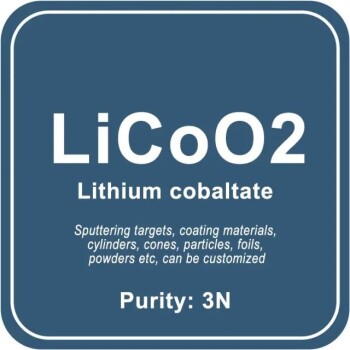
Lithium cobaltate (LiCoO2) Sputtering Target / Powder / Wire / Block / Granule
Find high-quality Lithium cobaltate (LiCoO2) materials tailored to your needs at reasonable prices. Discover our range of sizes and specifications for sputtering targets, coatings, powders, and more.
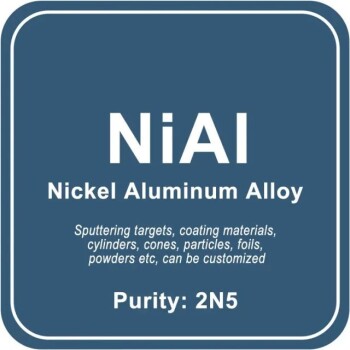
Nickel Aluminum Alloy (NiAl) Sputtering Target / Powder / Wire / Block / Granule
Looking for high-quality Nickel Aluminum Alloy materials for your lab? Our experts produce and customize NiAl materials to suit your specific needs. Find a wide range of sizes and specifications for sputtering targets, coating materials, and more at affordable prices.

High Purity Aluminum (Al) Sputtering Target / Powder / Wire / Block / Granule
Get high-quality Aluminum (Al) materials for laboratory use at affordable prices. We offer customized solutions including sputtering targets, powders, foils, ingots & more to meet your unique needs. Order now!

Aluminum Copper Alloy (AlCu) Sputtering Target / Powder / Wire / Block / Granule
Get high-quality Aluminum Copper Alloy (AlCu) materials for your laboratory needs at affordable prices. Customized purities, shapes, and sizes available. Shop sputtering targets, coating materials, powders, and more.
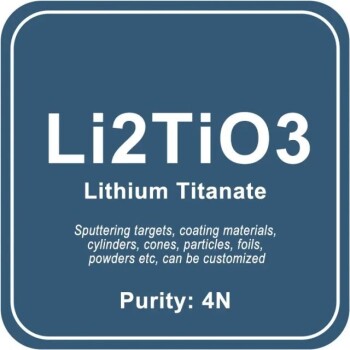
Lithium Titanate (Li2TiO3) Sputtering Target / Powder / Wire / Block / Granule
Get high-quality Lithium Titanate materials for your lab needs at affordable prices. We offer tailored solutions with different shapes, sizes, and purities. Find sputtering targets, powders, and more in various specifications.

CVD Diamond Coating: Superior Thermal Conductivity, Crystal Quality, and Adhesion for Cutting Tools, Friction, and Acoustic Applications
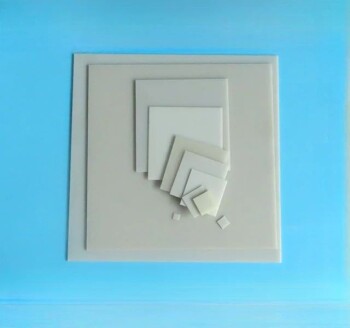
Aluminum Nitride (AlN) Ceramic Sheet
Aluminum nitride (AlN) has the characteristics of good compatibility with silicon. It is not only used as a sintering aid or reinforcing phase for structural ceramics, but its performance far exceeds that of alumina.
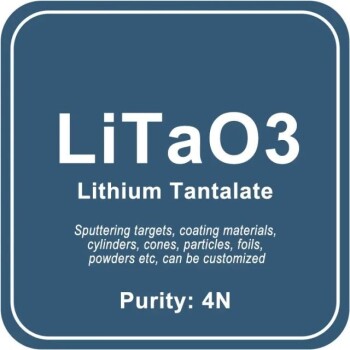
Lithium Tantalate (LiTaO3) Sputtering Target / Powder / Wire / Block / Granule
Find affordable Lithium Tantalate materials for laboratory use at our company. We specialize in producing tailored shapes and sizes to suit your unique needs, including sputtering targets, coating materials, and more.

Plasma enhanced evaporation deposition PECVD coating machine
Upgrade your coating process with PECVD coating equipment. Ideal for LED, power semiconductors, MEMS and more. Deposits high-quality solid films at low temps.
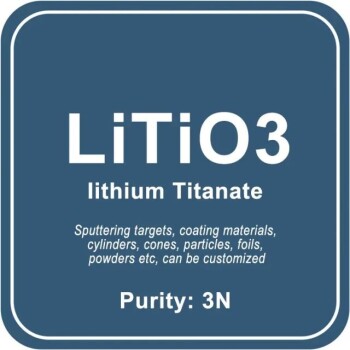
Iithium titanate (LiTiO3) Sputtering Target / Powder / Wire / Block / Granule
Get high-quality Iithium Titanate (LiTiO3) materials for your laboratory at reasonable prices. Our tailored solutions cater to different purities, shapes, and sizes, including sputtering targets, coating materials, powders, and more. Order now!

CVD diamond for thermal management
CVD diamond for thermal management: High-quality diamond with thermal conductivity up to 2000 W/mK, ideal for heat spreaders, laser diodes, and GaN on Diamond (GOD) applications.
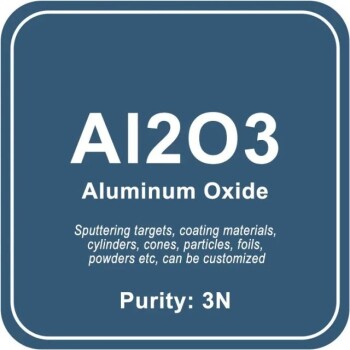
High Purity Aluminum Oxide (Al2O3) Sputtering Target / Powder / Wire / Block / Granule
Looking for Aluminum Oxide materials for your lab? We offer high-quality Al2O3 products at affordable prices with customizable shapes and sizes to meet your specific needs. Find sputtering targets, coating materials, powders, and more.

CVD boron-doped diamond: A versatile material enabling tailored electrical conductivity, optical transparency, and exceptional thermal properties for applications in electronics, optics, sensing, and quantum technologies.

Aluminum Nitride (AlN) Sputtering Target / Powder / Wire / Block / Granule
High-quality Aluminum Nitride (AlN) materials in various shapes and sizes for laboratory use at affordable prices. Explore our range of sputtering targets, coatings, powders, and more. Customized solutions available.

Customer made versatile CVD tube furnace CVD machine
Get your exclusive CVD furnace with KT-CTF16 Customer Made Versatile Furnace. Customizable sliding, rotating, and tilting functions for precise reactions. Order now!

Aluminum Boride (AlB2) Sputtering Target / Powder / Wire / Block / Granule
Looking for high-quality Aluminum Boride materials for your lab? Our custom-tailored AlB2 products come in various shapes and sizes to suit your needs. Check out our range of sputtering targets, coating materials, powders, and more.

Electron Beam Evaporation Coating Oxygen-Free Copper Crucible
Electron Beam Evaporation Coating Oxygen-Free Copper Crucible enables precise co-deposition of various materials. Its controlled temperature and water-cooled design ensure pure and efficient thin film deposition.

Hemispherical Bottom Tungsten / Molybdenum Evaporation Boat
Used for gold plating, silver plating, platinum, palladium, suitable for a small amount of thin film materials. Reduce the waste of film materials and reduce heat dissipation.

CVD Diamond Cutting Tools: Superior Wear Resistance, Low Friction, High Thermal Conductivity for Non-Ferrous Materials, Ceramics, Composites Machining

Alumina (Al2O3) Ceramic Rod-Insulated
Insulated alumina rod is a fine ceramic material. Alumina rods have excellent electrical insulating properties, high chemical resistance and low thermal expansion.

Boron Nitride (BN) Ceramic Tube
Boron nitride (BN) is known for its high thermal stability, excellent electrical insulating properties and lubricating properties.
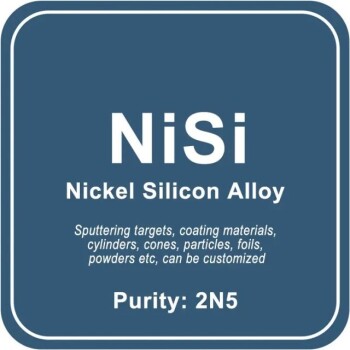
Nickel Silicon Alloy (NiSi) Sputtering Target / Powder / Wire / Block / Granule
Looking for Nickel Silicon Alloy materials for your lab? Our expertly produced and tailored materials come in various shapes and sizes to suit your unique needs. Get sputtering targets, coating materials, powders, and more at reasonable prices.

Vessels for high temperature applications, where materials are kept at extremely high temperatures to evaporate, allowing thin films to be deposited on substrates.

Aluminized ceramic evaporation boat
Vessel for depositing thin films; has an aluminum-coated ceramic body for improved thermal efficiency and chemical resistance. making it suitable for various applications.
Related Articles

Comprehensive Guide to Handheld Alloy Analyzers: Features, Applications, and Benefits
Explore the advanced features, wide-ranging applications, and significant benefits of handheld alloy analyzers. Learn how these devices revolutionize alloy analysis with fast, accurate, and non-destructive testing methods.

Introduction to the Casting Process for Sputtering Targets
A comprehensive guide to the casting process for sputtering targets, including suitable materials, advantages, and detailed process steps.

AI Chip Advancement Driven by Metallic New Materials
Explores how AI chip upgrades are fueled by new metal materials, impacting computing power and semiconductor manufacturing.

Design and Application of Reference Electrodes in Lithium Batteries
This article discusses the selection and design of reference electrodes for lithium batteries, focusing on active materials like lithium metal, lithium alloys, and lithium-embedded oxides.

Design Principle and Application of Reference Electrodes for Lithium Batteries
Discusses the design principles, types, applications, and future directions of reference electrodes in lithium batteries.

Preparation Methods for High Purity Aluminum Oxide
An overview of various methods to produce high purity aluminum oxide, including hydrolysis, pyrolysis, modified Bayer, precipitation, baking, sol-gel, and spark discharge methods.

Introduction to Sputtering Targets
An overview of sputtering targets, their types, and key parameters like purity, density, and grain size.
